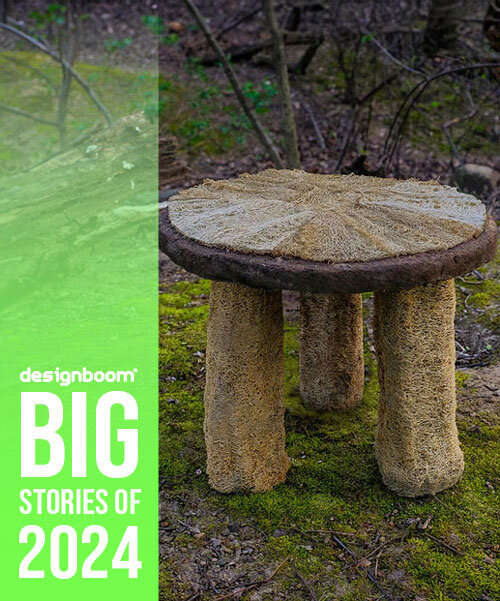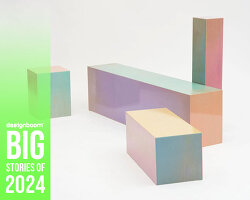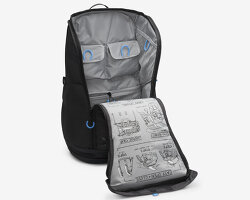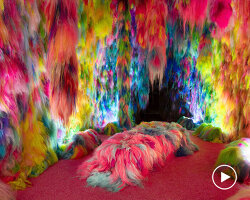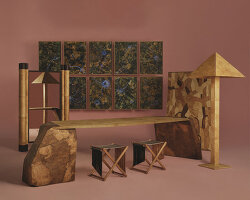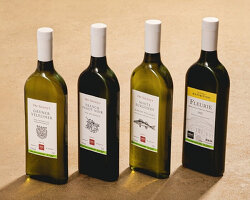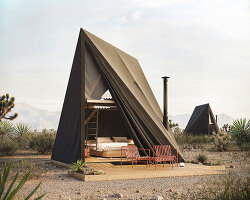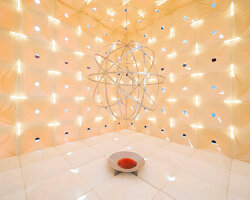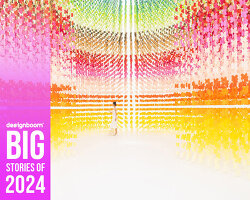top 10 innovative material applications in 2024’s design projects
The year 2024 saw designers and architects reimagine material applications in more sustainable and environmentally responsible ways. Zero-waste alternatives replaced traditional construction methods, as seen in ReGrow Willow’s hybrid material system that combines willow and pressed earth for architectural applications. Projects like André Kong Studio’s mushroom mycelium brick pavilion in New York and Studio dreiSt’s recyclable canteen furniture crafted from construction waste pushed the boundaries of conventional techniques.
Natural materials once considered waste emerged taking the place of synthetic options, such as Studio Sanne Visser’s use of human hair yarn applied on furniture and accessories. From Gisung Han’s decomposable stool made of wildflower seeds and potato-based plastic to Studio Arp’s pendant lamp shaped from leather derived from citrus waste, these projects embraced circular design principles. Our 2024 big stories include Mengyan Guo’s sculptural clothing collection crafted from discarded tea leaves, upcycled stools made from spent shower sponges and coffee grounds designed by Columbia University students, and Laura Bordini’s packaging series, which repurposes microalgae and industrial waste biomass to promote ecological regeneration. designboom rounds up 2024’s top 10 projects that stood out for their creative use of materials for practical, and sustainable designs.
FROM CHOW TO CHAIR: UPCYCLED STOOLS MADE FROM SPENT SHOWER SPONGES AND COFFEE GROUNDS

image courtesy of Justin Wan
The Luffa Stoolita explores the potential application of plant-based by-products, particularly their subsequent food wastes, as alternative materials for furniture design and construction. Realized by Columbia University GSAPP master’s students Justin Wan, Paul Edward Liu, and Tim Ting-Hao Chen, the project challenges conventional materiality in the realm of sustainable furniture, while prompting reflection on responsible consumption and waste management. By upcycling natural waste materials, the stool design demonstrates the possibility of extending the life cycle of food beyond its short-lived consumerist lifespan aligned with low-impact design solutions to address the issue of food waste. To ensure environmental sustainability, all materials used in the research and design project are locally sourced.
read more here
LAURA BORDINI REPURPOSES MICROALGAE AND INDUSTRIAL WASTE BIOMASS TO NOURISH PLANT LIFE
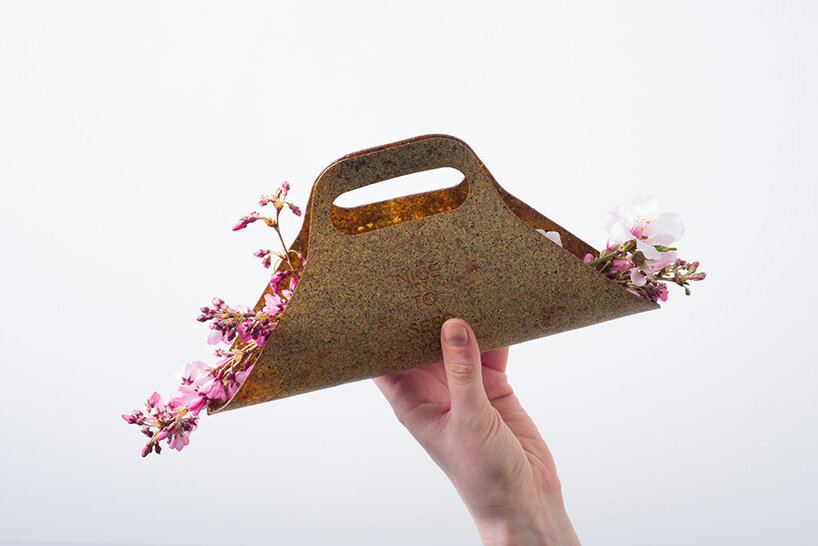
image courtesy of Laura Bordini
Laura Bordini’s By Osmosis explores a circular process in which waste generated by one process becomes nourishment for another. The project showcases the potential of ‘growing materials’, particularly microalgae, in promoting ecological regeneration by actively contributing to fostering plant life.
Using biomass derived from the death of microorganisms recovered from industrial waste centers, the designer demonstrates how this product can be transformed into a biomaterial that stimulates plant growth. Bordini presents a series of products, such as packaging materials, designed to be planted and function as agricultural biostimulants.
read more here
VIENNA’S CONSTRUCTION WASTE BECOMES RECYCLABLE FURNITURE FOR CANTEEN BY STUDIO DREIST

image by Paul Sebesta, courtesy of Studio dreiSt
Bioregional design practice Studio dreiSt unveils Biofabrique canteen, the modular hospitality area of Vienna Design Week 2024. Designed in collaboration with the material-driven project Biofabrique Vienna, the canteen incorporates 1,700 handmade ceramic tiles glazed with metro excavation clay, demonstrating how materials like clay from Vienna metro construction sites and food production residuals can be repurposed into long-lasting, recyclable building components. The golden-brown surface of the ceramic glaze is derived from subway excavation clay and carbolime, while energy-efficient materials like Carbo and Adobe bricks are utilized to construct bar tables and counters.
read more here
HUMAN HAIR SPINS INTO YARN IN STUDIO SANNE VISSER’S INSTALLATION FOR LONDON DESIGN FESTIVAL

image by Rocio Chacon
Material design research practice Studio Sanne Visser introduces Locally Grown, an interactive installation exploring human hair as an innovative, sustainable material. Presented at the Material Matters Fair during the London Design Festival, the project invites visitors to engage with the full process, from live haircuts to hair spinning and rope-making demonstrations, resulting in an exhibition of design objects made from hair. The installation emphasizes collaboration and circular economy, featuring contributions from nine studios, including Helen Kirkum Studio, Lauren MacDonald, and Wilkinson & Rivera, who integrate Visser’s hair-based materials into a variety of products, ranging from high-quality interior objects to unique accessories.
Sanne Visser emphasizes the collaborative spirit behind her work, stating, ‘I work independently, but I would never say I work alone.’ This ethos is at the heart of the installation, blending collective creativity, ecological responsibility, and innovative design with sustainable material solutions.
read more here
MYCELIUM BRICK PAVILION BY ANDRE KONG STUDIO SPROUTS IN NEW YORK BOTANICAL GARDENS

image by Marlon Co for NYBG
Homegrown Wonderland is an organic garden pavilion created by andre kong studio for the New York Botanical Garden’s latest exhibition. As Wonderland: Curious Nature explores the fantastical world of Lewis Carroll’s Alice’s Adventures, the installation features bricks grown from mycelium—the root structure of mushrooms. This innovative materiality reflects the scene where Alice consumes a mushroom and grows rapidly, evoking a whimsical transformation as she outgrows the White Rabbit’s cottage.
Engineered by Arup, the pavilion juxtaposes a quaint, aged timber-frame cottage, scaled down to create an intimate setting, with unexpected walls crafted from full-sized mycelium bricks. The pavilion will be dismantled after its display in the gardens, with the mycelium bricks composted, and the timber will be reused.
read more here
GISUNG HAN’S POTATO PLASTIC-BASED STOOL BLOOMS INTO WILDFLOWERS AS IT DECOMPOSES

image courtesy of Gisung Han
Gisung Han’s Blooming Decay Stool is made from wildflower seeds and potato-based plastic, designed to bloom into flowers as it decomposes. The project stems from the designer’s desire to create various types of bioplastics with artful, sustainable principles and with manufacturability in mind.
‘Does a chair designed with sustainable principles always need to be durable and long-lasting? How about a chair that breaks easily, becoming more beautiful as it deteriorates?’ Han questions. As a result, the stool embraces the beauty of disappearance, envisioned to be disposable and biodegradable, naturally dispersing seeds back into the environment as it ages.
read more here
‘REGROW WILLOW’ POSES HYBRID EARTH CONSTRUCTION SYSTEM STRENGTHENED WITH DIGITAL FABRICATION

image courtesy of Karlsruhe Institute of Technology (KIT)
ReGrow Willow presents an innovative hybrid material system that pairs the tensile strength of willow with the compressive strength of earth for architectural applications. Developed by professorships at the Karlsruhe Institute of Technology (KIT), this comprehensive construction process leverages bespoke digital fabrication and computational tools to advance the synergistic combination of the two natural materials. Embracing lightweight, mobile, and adaptable fabrication equipment, the project embodies a low-impact design philosophy to reduce energy and material consumption, offering a sustainable structural alternative to reinforced concrete.
Championing a circular ethos, the project further seeks to integrate alternative materials and closed-loop systems into construction practices, addressing resource depletion and waste generation. By disrupting the traditional linear model of take, make, and dispose, ReGrow Willow aims to establish a waste-free and fully circular digital construction, closing local material cycles.
read more here
LEATHER-LIKE MATERIAL FROM CITRUS WASTE WRAPS PENDANT LAMP AT LONDON DESIGN FESTIVAL

image by Stone Stuart courtesy of Studio Arp
Interdisciplinary practitioner Alkesh Parmar, founder of Studio Arp, repurposes orange peel waste into sustainable materials in the Citrus Sinensis project. Incorporating traditional craftsmanship and low-tech processes, the studio explores themes of migration, colonialism, and decentralized design. Showcased at the Material Matters Fair during the London Design Festival, this project includes lighting, objects, and artworks, emphasizing the intergenerational preservation of craft and the sustainable use of natural resources, while drawing on the origins of the orange from the Himalayan foothills.
Through his innovative process, APeel, Parmar transforms waste citrus peel into a versatile leather-like material suitable for diverse applications. In a crucial phase before the orange peel dries, it becomes pliable and moldable, similar to leather, with its properties varying based on the type of citrus and environmental conditions—ensuring an adaptable and sustainable process. Low-tech craft techniques emphasize the potential of local materials, challenging conventional Western design practices.
read more here
ECO-FRIENDLY PACKAGING BY BIOREGION INSTITUTE REPURPOSES BARLEY WASTE AND SEAWEED

image courtesy of Bioregion Institute
Lab director Alexandre Bau, industrial biochemist Lars Haugen Aardal, and industrial designer Alvise Rizzo from the Bioregion Institute introduce Feddie Packaging, an eco-friendly packaging solution crafted from whiskey distillation byproducts and locally sourced seaweed. This innovative biomaterial offers a low-cost, low-carbon alternative to pulped cellulose, advancing sustainable packaging design.
The biomaterial repurposes draff—the spent malted barley grains left over from whiskey production—as a raw material rich in starch, proteins, and fibers. Typically used as animal feed or compost, draff’s natural properties make it an ideal base for molded pulp packaging. To enhance its functionality, the team combines draff with sugar kelp, a seaweed cultivated along Norway’s coast. This land-and-sea biomass pairing leverages the adhesive qualities of alginate, a natural polysaccharide found in kelp, to create a robust, shock-absorbing packaging material. ‘By converting this waste biomass into a useful product without compromising biodegradability, we extend its life cycle and offer a cheap alternative resource to the molded pulp packaging industry,’ affirms the team. ‘We leverage the residual starch in draff as a natural binder, a key component that provides strength and elasticity to the material.’
read more here
SCULPTURAL TOP AND SKIRT MADE OF DISCARDED TEA LEAVES CAN ABSORB ODOR

image courtesy of Mengyan Guo
The sculptural top and skirt follow the veins and shapes of tea leaves, trees, and insects. It’s no wonder Mengyan Guo took this path since she wanted to thread nature with biomaterials for TeaFab, a means to thread nature with man-made designs. The result springs from the collar made of repurposed tea leaves, bent and twisted to hark back to the natural formations of tree branches and roots. Even the decorations are a mix of tea tree and shapes of insect legs, while the heart of the clothes features a blend of insects’ skeletal structure and the texture of tea leaves.
read more here
see designboom’s TOP 10 stories archive:
2023 — 2022 — 2021 — 2020 — 2019 — 2018 — 2017 — 2016 — 2015 — 2014 — 2013
algae (35)
chair design (670)
earth architecture (68)
fashion design phenomena (251)
hair art and design (20)
lighting design (508)
materials (115)
mushroom mycelium (39)
packaging design (109)
recycling (382)
table design (150)
TOP 10 LISTS OF 2024 - BIG STORIES (13)
PRODUCT LIBRARY
a diverse digital database that acts as a valuable guide in gaining insight and information about a product directly from the manufacturer, and serves as a rich reference point in developing a project or scheme.
